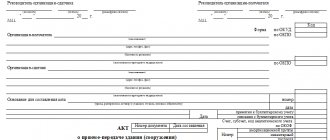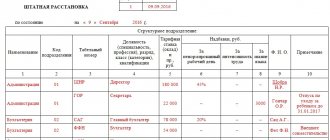The act of acceptance and transfer of documents is intended to reflect the fact of transfer of documentation from one responsible person to another and confirms that one party transmitted information and the other received it. The executed deed must contain the signatures of the parties involved in the transfer. This is necessary to avoid controversial situations.
The document is used when the company changes the director or employee heading the accounting department. The resigning employee provides all materials to the new one. If this transfer is not legally recorded, the company risks losing important information. After all, information is the most important resource that every company uses.
- 1 Purpose
- 2 Legal force
- 3 Basic rules for drawing up a transfer and acceptance certificate 3.1 Instructions on how to draw up a document transfer and acceptance certificate
What kind of document is this and is it necessary to prepare it?
The act of acceptance and transfer of documents is formed within the framework of corporate relations. This is a document that reflects the transfer of accounting, constituent and other documents from one person to another (or from one organization to another). The act signed by representatives of both parties confirms the fact that one participant in the legal relationship handed over the documentation, and the second received it.
The current legislation does not require that an act of acceptance and transfer of accounting documents or other internal documentation must be drawn up. But despite this, officials often use it. The document has legal significance, and if it comes to legal proceedings due to the loss of any papers, etc., it will act as important evidence.
This document is especially important if there is a change in the manager, his deputies or the chief accountant. This process is always accompanied by the delivery of cases, so every little detail is important here. Before signing the act, the interested party must check the package of documents provided to him, otherwise he may subsequently encounter unexpected troubles.
Form
The law does not provide for the use of a unified form for drawing up an act. Therefore, it is allowed to draw up the document in a free style. Some companies develop a special template for this purpose, using it exclusively.
If you choose the free form option, it is recommended to use a regular A4 sheet. You need to understand that both parties must receive confirmation that the transfer of documents has taken place. Naturally, for this, the act must have two copies, each of which is signed “live” by the company’s managers. Such signatures cannot be avoided even in situations where the document was filled out using a computer.
( Video : “Legal documents Act of acceptance of transfer”)
In what cases is an act required?
The powers of company managers allow them to decide for themselves when the need arises to draw up such a document. Often its registration is carried out by mutual desire between the parties. Quite often, all parties to the transaction are interested in this. One party has proof that it actually handed over all the specified documents, and the second has a complete list of the documentation received.
The act can be drawn up not only in a transaction between organizations. It is also created when transferring documentation within the company.
The act is drawn up in the following situations:
- One employee hands over documents to another;
- If the company's officials change;
- Changes are made to the company’s internal documentation;
- Documents are submitted to the archives.
The situation when the director or chief accountant changes at an enterprise deserves special attention. The person taking up these positions must take over the work of his predecessor. At the same time, you need to remember that even minor little things can turn out to be quite important. That is why, when accepting cases, it is recommended to carefully read the documents being accepted. An official who is just starting to work in a new company should try to avoid serious troubles in the future. And the package of documents that was handed over by the predecessor will help with this.
Features of document preparation
The form of the act of acceptance and transfer of documents is not established at the legislative level. Each organization has the right to develop it at its own discretion. The document must include the following details:
- its full name;
- date and place of compilation;
- company name;
- composition of the commission (if appointed);
- a detailed list of documents transferred from one individual to another;
- assigned registration numbers of documents, cases, etc.;
- FULL NAME. and signatures of persons (who submitted and who accepted);
- signatures of the commission members.
When drawing up an act of acceptance and transfer of accounting documents, significant attention should be paid to the papers that are transferred in the original. A note about this must be made in the act. If the party that accepted the financial documentation loses some document and tries to blame the other party for it, you can always prove your case in court. It is also recommended to make copies of all transferred papers.
How to submit documents to the Federal Tax Service
You can transfer documents and information during desk and field inspections:
- on paper - in person or by registered mail;
- electronic - via TKS or through the taxpayer’s personal account (for clarifications on VAT - the only way).
In addition to the copies, issue a cover letter in which you indicate the details of the request in response to which you are submitting the documents, its date and number. Make an inventory of documents, which can be part of the letter or an attachment to it.
Sample cover letter for submitting documents to the Federal Tax Service in 2020
[td]Sample cover letter on transfer of documents to the Federal Tax Service
Sample register of documents that are transferred to the Federal Tax Service in 2020
Drawing up an act when changing the general director
Drawing up an act of acceptance and transfer of documents when changing the director is a typical procedure related to the peculiarities of corporate relations. Some of the documentation is extremely difficult to restore, so the fact of transfer is carefully recorded. The receiving party should pay great attention to checking the constituent documents, licenses, powers of attorney, and contracts. If necessary, photocopies of the most important papers and a list of documents are attached to the act.
The direct obligation of the general director to transfer documentation under the act is not recorded anywhere. However, in paragraph 4 of Art. 29 of the Law “On Accounting” dated December 6, 2011 No. 402-FZ states that when changing the head of the company, it is necessary to ensure the transfer of accounting documents. Each organization determines the transfer procedure independently. Provisions regulating the mandatory transfer of documentation from the former general director to the new one should be enshrined in the local standards of the organization.
Classification
In addition to primary and accounting documents, accounting documents may have other classifications. For example, they are:
- internal and external;
- administrative and exculpatory;
- one-time and cumulative;
- strict accounting and ordinary.
For each operation or transaction there is a separate list of required securities. Usually the supplier prepares the initial documentation, but it is the buyer who is interested in ensuring that everything is done correctly and without deviations from the rules. Because he receives goods, services or intangible assets on the basis of these official papers, pays money and claims to receive tax deductions.
Recommendations for drawing up the act
- The act of acceptance and transfer of documents (a sample of a simple form can be used as an example) is drawn up on the organization’s letterhead.
- The document can be generated on a computer or filled out by hand.
- The act is drawn up in two copies, one for each of the parties.
- Each copy must bear the signatures of officials and members of the special commission (if it was created).
- Certification with a seal is not required, but it can be done if desired.
- The act should contain a complete list of transferred cases (folders). If necessary, a separate application can be used to create a detailed inventory of investments in them. It is necessary to correctly indicate the name and number of available copies of documents.
- If valuable documents are transferred, the act indicates the full details of the organization and passport details of the interested parties. When transferring standard documentation, you can use a simple deed form.
Since the general director and chief accountant are financially responsible persons, before transferring affairs they are required to conduct an inventory of property and documents. This is stated in paragraph of the Methodological Instructions, approved. by order of the Ministry of Finance of the Russian Federation dated December 28, 2001 No. 119n.
Purpose and legal effect
The document has full legal force, and despite the fact that its role often seems purely formal, this is not entirely true.
Purpose:
- Document the transfer of documents:
a complete list of all papers;
- their number;
- their type (original, copy, certified copy);
- date of transmission (sometimes time);
- transferor;
- receiving party.
- Use it as the main evidence if necessary (most often in legal proceedings).
Document destruction act
The act of destruction of documents is documentary evidence of the need for disposal of documentation. This includes papers:
- expired;
- that are not important for the current and future activities of the company;
- which do not carry scientific and historical significance for the organization.
The act is drawn up in any form; a form approved by the enterprise is also accepted. Papers of any structural unit are recycled. For this purpose, an expert commission with at least two participants is first created. In this case, the commission must include a person from the department whose documents are written off for destruction.
The commission makes a decision on the allocation of documents for destruction and, based on the results of the analysis, draws up a report. Regardless of the template, it indicates:
- general organizational information (date of compilation, date of disposal, number of approved order, justification for destruction of documentation);
- information about the members of the commission;
- a list of papers whose storage period has expired, or which is impractical to store (the name of the folders, numbers according to the nomenclature of files, quantity, date of establishment, etc. are described in detail);
- the method of destruction is indicated.
We propose to consider an example of the destruction of accounting documents.
By the way! The commission has the right to decide on the allocation for destruction of documents that are not subject to storage.
What is the act of transfer of affairs upon dismissal of the chief accountant?
The act of transfer of affairs upon dismissal of the chief accountant is a document that allows the successor and management of the resigning chief accountant to know in what financial condition the enterprise is being transferred.
Such a document is needed so that the chief accountant who terminates the cooperation not only transfers all the folders with documentation according to the inventory, but also conducts an inventory of all material resources, including fixed assets.
Quarterly and annual reports, the status of settlements with employees, suppliers, subcontractors, contractors, tax calculations, the balance sheet of the enterprise - these and other issues must be covered and documented. Therefore, it is necessary to transfer reconciliation acts, registers of receivables and payables, tax papers, etc. to the new financial manager.
After the chief accountant receives the payment and leaves, it will be difficult to make inquiries and find out how and why the shortage of funds occurred. The act of transferring affairs will give the successor an idea of how accounting was conducted, what the financial policy was, and whether there were any abuses.
Accounting documents
Any accounting document is a form of a certain form that has mandatory details. Globally, they can be divided into two large groups:
The first includes all those papers and electronic files that are compiled at the time of the transaction and certify the fact of its completion. Document flow in accounting is regulated by the Federal Law on Accounting. Accounting registers are formed on the basis of primary documentation; they contain accounting records and transactions. In addition, they serve for primary registration. Let's consider the importance of accounting documents, requirements for their execution and storage periods in more detail.
Accounting registers
Accounting documents, or, in other words, accounting documents, are used to systematize and accumulate information contained in primary documents accepted for accounting, as well as to reflect this data on accounting accounts and reporting. You can lead them:
- in special books (magazines);
- on separate sheets and cards;
- in the form of machine diagrams obtained using computer technology;
- directly in specialized programs on electronic media.
It is important to observe the chronology of data entry and accounting principles: double entry, maintaining synthetic and analytical accounting, application of a general Chart of Accounts and others. Based on data from accounting registers, reports are compiled, which organizations submit to Rosstat and the Federal Tax Service.
Shelf life
The storage periods for accounting documentation depend on the form of the primary document or register. They are established by the law on accounting and a special list approved by order of the Ministry of Culture of the Russian Federation dated August 25, 2010 No. 558. The total period provided for by law is 5 years. But the list provides more specific deadlines. For example, reporting must be kept as long as the organization operates, and information on the income of individuals must be kept for at least 75 years if there are no personal accounts of employees. The storage period begins with the year following the year of their last use, but sometimes it is calculated according to a different principle. For example, certificates of work performed under a contract must be kept for at least 5 years from the expiration date of the contract.










